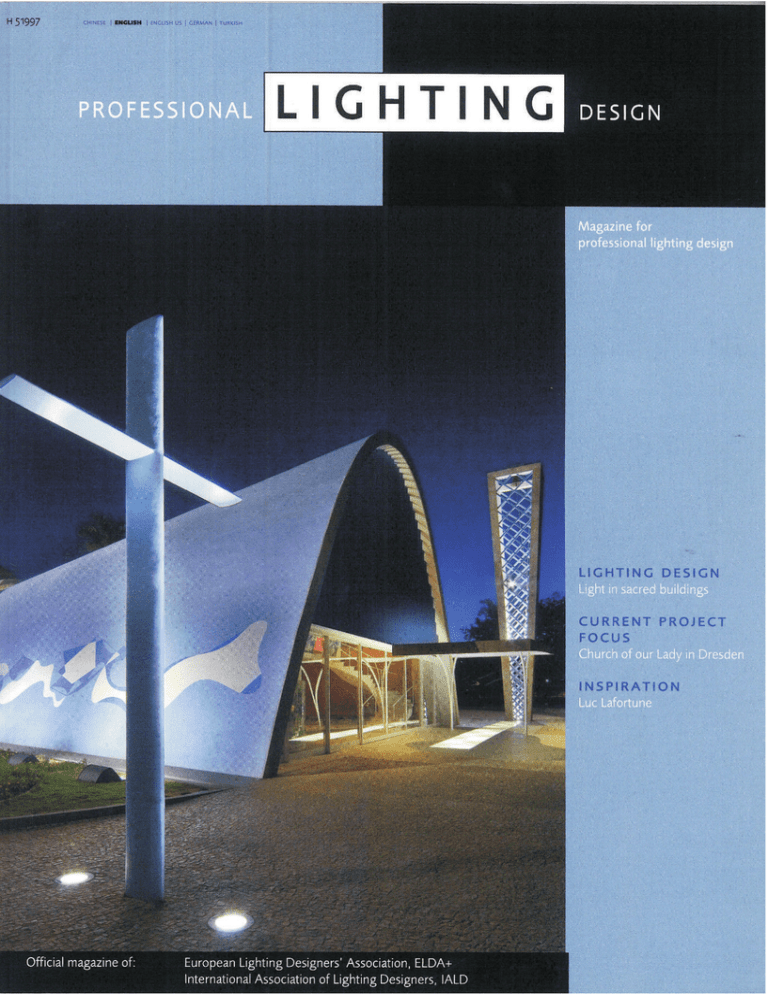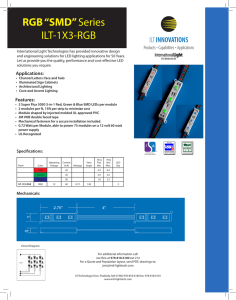Untitled - LD Studio
advertisement

LIGHTING DESIGN 26 Gem The renovation of the Church of St. Francis of Assisi in Pampulha/BR. Text: Monica Luz Lobo, Petra Steiner Photos: Jomar Bragança Built in 1943 and designed by Oscar Niemeyer, pioneer of modern Brazilian architecture, the little church named after St. Francis of Assisi in Pampulha is a real gem. And just as precious gems sparkle and radiate charm, so does this place of worship, especially since its renovation when the new lighting concept was implemented. One could go as far as to say it radiates from within – as precious objects do in their wonderful way. The architecture of the little church Igreja de São Francisco de Assis (Church of St. Francis of Assisi) has always been regarded as a remarkable building, especially since it has very little in common with conventional places of worship. When it was designed over sixty years ago, it gave rise to heated debate. It was not only the daring architectural design that was controversial. The use of concrete was equally revolutionary at that time, although no other building material would have allowed the construction of the parabolic roof. The main arch spans the choir level and the sanctuary. The tower and the entrance are free-standing elements and make for a stark contrast to the curved architectural components. The renovation of the Church of St. Francis of Assisi, also known as Igreja da Pampulha because of the lagoon area where it is located, presented the internationally renowned architects and artists on the design team with an artistic challenge: to interpret the unique form of an architectural monument and reveal it through lighting. Care was taken to reveal the architecture, not to reinvent it. The main objective was to emphasize the peculiar forms of the building, with schemes for both interior and exterior. The church is protected by all four of the Brazilian heritage protection organizations, so each design solution had to be approved by numerous governmental agencies. The interior lighting had to be incorporated within the existing architecture. The concept was that the light would embrace the architecture and not be something added. The team from Lighting Design Studio tried to limit the visual interference of lighting fixtures that could distract the eye from the clean, architectural lines. The outer screen wall on the north side (rear façade) is finished with a tiled mural depicting scenes from the life of St. Francis. The lighting solution consists of continuous rows of ground-recessed 28 watt 3000 K T5 fluorescent lamps, located 30 centimetres (approx. one foot) adjacent to the panel, providing uniform lighting at the base and emphasizing the concrete eaves. The design intent was to underline the volume of the cur- ves, adding intensity to the base. Asymmetric metal halide floodlights mounted at the base are complemented by metal halide spotlights (28 degrees) mounted on the existing street poles to wash the roof. The bell tower comprises a hollow, brick panel located as a separate element at the front of the church. It is linked to the main building via an awning. Mediumbeam metal halide floodlights positioned in the base accentuate the volume and the latticework. The awning at the front façade of the church is illuminated indirectly, using an existing recess covered with stained glass in the path. Metal halide floodlights bounce the light into the cavity. The brise soleil is lighted by indirect cove lighting using T5 fluorescent lamps mounted on the inner window frame sash. A metal cross stands sentinel to the left of the entrance. It is uplit by two inground metal halide fixtures with concentric louvers. The light from the front and rear highlights the arms and gives form to the vertical. The cross lends human scale to the structure. The visitor or worshipper approaches the welcoming entrance, which with its glazed front and winding staircase has a certain domestic quality. The materials used inside the church are expressly warm. The colours of the wood and the artwork, although sometimes rich in contrast, are enhanced by the bright, but soft lighting. Lighting coves equipped with 28 watt 3000 K T5 fluorescent battens located near the front facade (brise soleil) and choir balcony create indirect lighting, supplemented by medium flood AR111 luminaires located over the floor. In the main room of worship, Portinari’s altar panel is lit by symmetrical beam halogen projectors located in the transition space between the smaller dome of the church nave and the larger altar dome, and complemented by a series of AR111 narrow-beam (eight degrees) spots, to emphasize the axis. This transition is visible from the exterior. In the case of small projects, it is often the love of detail that has the greatest effect – that is what such smallscale structures appear to demand of the designers that The bell tower stands as a separate element in front of the church. The church and the bell tower are linked via an awning and via light. The cross to the left of the entrance is a clear sign that this is a Christian place of worship. Light from the front and rear highlights the arms and gives form to the vertical. Church of St. Francis of Assisi in Pampulha/BR 27 LIGHTING DESIGN 28 The rear facade of the church is decorated by a mosaic that depicts scenes from the ife of St. Francis. Inground luminaires wash the wall with uniform light and render the work of art visible after dark – the eaves are outlined in light and form a frame for the picture. The roof of the church comprises curved concrete elements. The surface of the roof is given a soft wash by floodlights positioned on the ground. Spotlights mounted on existing street lighting poles add emphasis. 2 x 28 watt 3000 K T5 lamps Site plan Cove lighting at the entrance: inside the church attention was also paid to hiding light sources and luminaires from view. The asymmetrical floodlights that wash the concrete facades are recess-mounted in the ground to maintain the impression that the architecture is untouched. 150 watt 3000 K CDM-TD 2 x HIT 3000 K Glass diffuser work on them. That is why this church is such an excellent example of sensitive, well designed lighting that responds to the existing architecture, enhancing but never interfering. Oscar Niemeyer's architecture formed the basis of the successful lighting concept, which was to become evident to all believers and non-believers (the effect of good lighting can leave a lasting impression, after all) even in the hours after dark. An effort has clearly been made to have the lighting respond to the architecture and all luminaires are either integrated into the architecture, which can be seen in the detailed planning, or installed so that they do not impair the atmosphere in the main room of worship. How many examples have we seen where existing street luminaires have been successfully integrated into the lighting concept? In this project very few new elements have been added. Existing architectural details are used to integrate lighting solutions. The rear outer facade of the little church with its parabolic curves and artwork depicting scenes from the life of St. Francis of Assisi looks more like an enormous work of art than a uniformly, but delicately lit building outlined in light. The atmosphere inside the place of worship is enhanced by soft light, with just the picture behind the altar creating a stark contrast – here, too, the concept is one of reticence and a focus on the essential. Overall, the lighting inside and out is gentle and discreet – one might also say pro-meditative – completely fitting for a place of worship, where people come to think and pray. And is that not an essential feature of real gems: the plainer they are, the more valuable they are likely to be? Church of St. Francis of Assisi in Pampulha/BR Project participants: Client: Fundação Roberto Marinho Architect: Oscar Niemeyer Lighting design: Lighting Design Studio, Rio de Janeiro/BR Products applied: Exterior Front façade: ceramic metal halide floodlights, 70 watt CDM-TD 3000 K, Lumini Back façade: ceramic metal halide spotlights ,150 watt CDM-T 3000 K 28O, Lumini Side façade: asymmetric ceramic metal halide floodlights, 150 watt CDM-TD 3000 K, Lumini Bell tower: ceramic metal halide floodlights, 2 x 70 watt CDM-T 3000 K, 1 x 150 watt CDM-T 3000 K, Lumini Cross: recessed metal halide fixtures with louvers, 35 watt CDM-R PAR30 3000 K 10O, Everlight Interior Entrance: lighting coves 28 watt 3000 K T5 fluorescent lamps, Everlight Choir balcony: lighting coves 28 watt T5 3000 K, Philips; medium floodlight 65 watt AR111 IRC 24O, Influencia da Luz Altar panel: 300 watt tubular halogen floodlights, Lumini; narrow-beam floodlight 65 watt AR111 IRC 8O, Lumini Light sources: Osram, Philips The recess at the entrance runs the length of the awning that acts as a linking element between the church building and the bell tower. View of the entrance from the altar: cove lighting provides indirect lighting and makes for a soft atmosphere. 29



